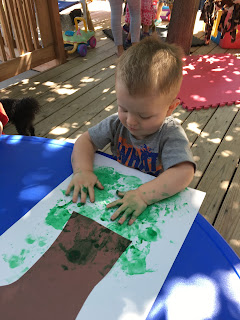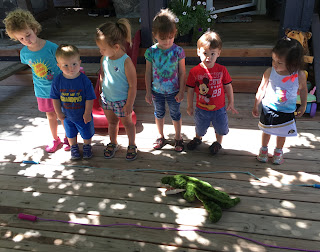We read an all-time favorite book about the rain forest called The Great Kapok Tree by Lynne Cherry. We were introduced to many animals of the Amazon Rain Forest and empathized with their plight- a man arrived to chop down the tree in which they lived. We were so happy when he dropped his ax at the end and walked out of the forest without chopping down the tree. The animals made a great case for not chopping down the tree.
Using our handprints as the leaves, we designed kapok trees- majestic trees of the tropical rain forest, home to many rain forest creatures.
The Amazon Rain Forest is filled with many primates-
We went swinging with the monkeys in the trees. As we swung, we chanted:
Three little monkeys swingin’ in a tree.
(swing arm to side with five fingers hanging down)
Teasing Mr. Caiman,
“You can’t catch me! You can’t catch me!”
(thumbs in ears, wiggle fingers)
Along comes Mr. Caiman,
(one hand on top of the other, moving as a caiman)
Quiet as can be…
(finger to lips as in shhhhh)
SNAP!
(clap hands together)
Two little…One little…
No little monkeys swingin’ in a tree
(swing arm with fist hanging down)
But here comes Mr. Caiman as fat as he can be!
(both arms out in front as in “fat”)
Three little monkeys swingin’ in a tree.
(swing arm to side with five fingers hanging down)
Teasing Mr. Caiman,
“You can’t catch me! You can’t catch me!”
(thumbs in ears, wiggle fingers)
Along comes Mr. Caiman,
(one hand on top of the other, moving as a caiman)
Quiet as can be…
(finger to lips as in shhhhh)
SNAP!
(clap hands together)
Two little…One little…
No little monkeys swingin’ in a tree
(swing arm with fist hanging down)
But here comes Mr. Caiman as fat as he can be!
(both arms out in front as in “fat”)
We read Jaguar by Helen Cowcher. Since jaguars got our vote for favorite animal of the Amazon Rain Forest, we read this book many times, which endeared us to the jaguar even more.
Jaguars are one of the largest predators in the Amazon Rain Forest. A jaguar’s spots that form rosettes on its fur, are like its fingerprints. The pattern of rosettes is unique to each individual jaguar. We used black and brown paint and spools of different sizes to make spots on jaguar shapes.
The Rain Forest Grew all Around by Susan K. Mitchell was another story about a kapok tree and its inhabitants.
We chanted about a humongous snake from the rain forest. A boa constrictor can grow to be up to 13 feet long. They squeeze their prey and then stretch their jaws wide to swallow large prey whole. It was fun to sing and play with the parachute. To the tune "Wheels on the Bus", we sang:
I’m being swallowed by a boa constrictor,
a boa constrictor, a boa constrictor,
I’m being swallowed by a boa constrictor,
and I don’t like it very much.
Oh, no. Oh, no. He swallowed my toes.
Oh gee, oh gee. He’s up to my knees.
Oh my, oh my. He’s swallowed my thighs.
Oh fiddle, oh fiddle. He’s up to my middle.
Oh bleck, oh bleck. He’s reached my neck,
Oh dread, oh dread. He’s swallowed my head.
I’ve been swallowed by a boa constrictor,
a boa constrictor, a boa constrictor.
I’ve been swallowed by a boa constrictor,
and I don’t like it very much!
We used paper plates cut in spirals and dot markers to create our own colorful snakes from the rainforest.
We used eye droppers and diluted paint to create beautiful butterflies from the South American Rain Forest. Butterflies are symmetrical, so we folded our butterfly shaped paper in half and then opened it up and dripped a few drops of vibrant colors of paint onto the paper. We then refolded the paper and smoothed it with our hands. When we opened it up, a beautiful butterfly appeared.
We tried a yummy tropical food that comes from the rain forest- pineapple. Pineapple belongs to the bromelaid family. We took turns holding it, feeling its rough, pokey exterior, and then we cut it up to taste it.
YUM!
The rain forest teems with an abundance of insects. Leaf cutter ants march through the rain forest carrying up to ten times their own weight in leaf pieces to take back to their underground nests.
We played a fun math game with ants, dice and a picnic tablecloth...
It helped us with counting, number recognition and one to one correspondence.
Picking up those little ants and placing them on the tablecloth, was great for our fine motor development!
We played, "Mr. Caiman, Can I Cross Your River, Please?". Caimans are members of the crocodilian family. They live in the rivers and lakes of the Amazon Rain Forest. We took turns being Mr. Caiman. We had to ask permission to jump over his river made with two jump ropes. Players asked, "Mr. Caiman, can I cross your river, please?" "Mr. Caiman" responded with, "Only if you’re wearing _________ (a certain color or certain piece of clothing)".
We took turns being Mr. Caiman.
We read The Umbrella by Jan Brett. It's about a little red-eyed tree frog in an umbrella dropped by a little boy who heads out to look for creatures of the rain forest. The frog is soon joined by other inhabitants of the rain forest who remain unseen by the little boy.
To the tune of "Five Green Speckled Frogs", we sang and dramatized:
Five red-eyed tree frogs (Hold up 5 fingers)
Sitting in the rainy fog (Make raining motion with fingers of both hands)
Eating some most delicious bugs,
(Fingers to mouth as if eating)
Yum, yum. (Rub stomach)
One jumped into the pool
(Point finger up and then down as in jumping)
Where it was nice and cool (Use hand as fan)
Then there were four red-eyed tree frogs.
(Hold up 4 fingers)
Four...Three...Two...One...
Sitting in the rainy fog (Make raining motion with fingers of both hands)
Eating some most delicious bugs,
(Fingers to mouth as if eating)
Yum, yum. (Rub stomach)
One jumped into the pool
(Point finger up and then down as in jumping)
Where it was nice and cool (Use hand as fan)
Then there were four red-eyed tree frogs.
(Hold up 4 fingers)
Four...Three...Two...One...
Many bright colored birds live in the canopies of the Amazon rain forest- toucans, macaws, and cock-of-the-rock. They like to eat fruit, seeds and nuts. We mixed together some dried fruits like raisins, banana chips, pineapple, papaya and mango, added some nuts and chocolate chips to create a "Macaw Mix" of special treats from the rain forest. We used different kinds of "bird beaks" to eat our treats. We had toothpicks to poke the soft fruit, clothespins and tweezers for pinching nuts, straws for sucking and spoons for scooping.
We always have such a great time in the rain forest.
We'll be back soon!

























































































































No comments:
Post a Comment